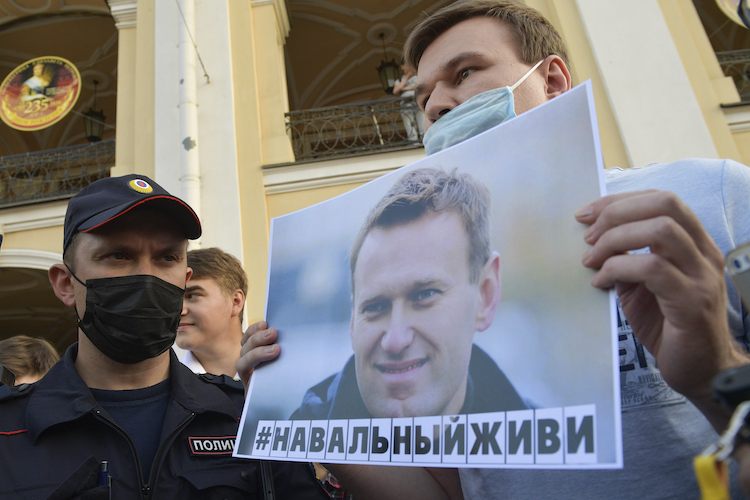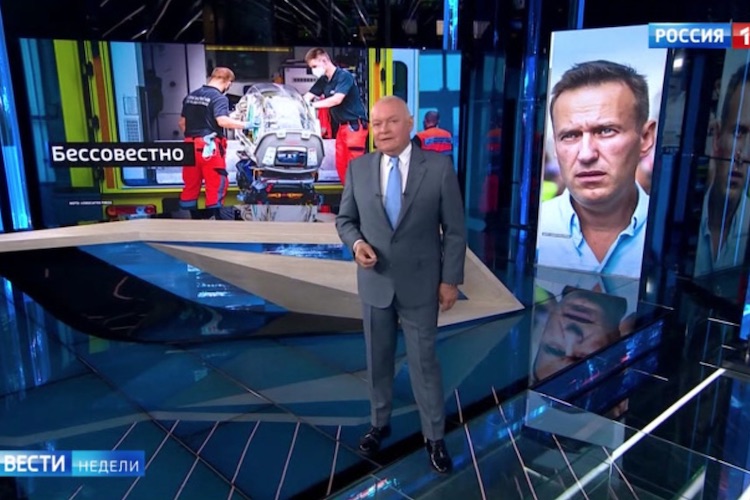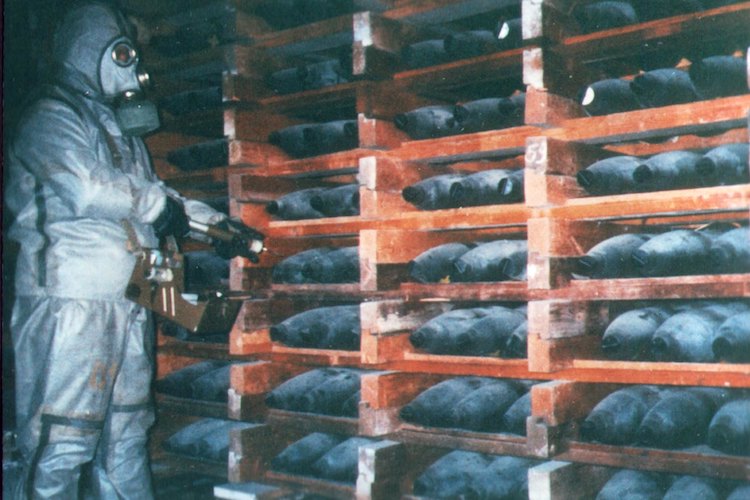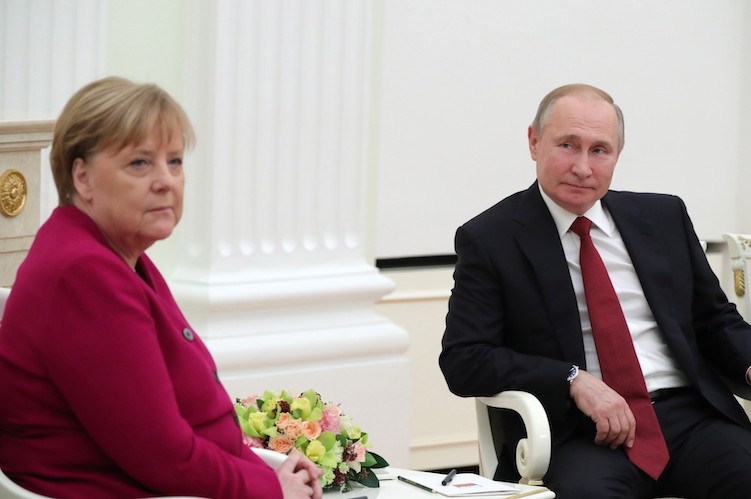The attempt on the life of opposition leader Alexei Navalny has become one of the central political events in Russia, but most Russians do not believe that the oppositionist was deliberately poisoned. Despite criticism from Western leaders, the Kremlin refuses to open a criminal investigation and continues to manipulate the facts. IMR’s analysis shows that the accusations made against the Russian state about the illegal use of chemical weapons are valid, but evidence is insufficient. International sanctions are imminent, as the West seeks to punish the Putin regime, but they will likely hurt less than the destruction of Russia’s special relations with Germany.

August 20, 2020, St. Petersburg: single-man pickets in support of Alexei Navalny took place across Russia. Photo: Alexander Galperin / Sputnik via AP.
Facts
The timeline of the poisoning of Alexei Navalny is well documented, but very briefly it looks like this. On August 20, the oppositionist felt unwell during a flight to Moscow from the Siberian city of Tomsk. The plane urgently landed in Omsk, where paramedics initially diagnosed Navalny with poisoning and injected him with an antidote. In a local hospital, the oppositionist fell into a coma, but this time local doctors diagnosed him with a metabolic disorder.
Then, under pressure from the politician’s family and friends, as well as due to the unraveling international scandal, the Russian authorities were forced to allow Navalny to be transported to the Berlin hospital Charité, where, having spent three weeks in an induced coma, he finally woke up in mid-September. As his colleague Ilya Yashin noted, Navalny survived by mere chance: an emergency landing in Omsk, timely administration of an antidote, and transfer to a specialized German clinic.
On September 2, German authorities released Navalny’s test results. A toxicological examination, carried out by the Bundeswehr specialized laboratory, found “unequivocal proof” of the presence in his body of traces of a chemical nerve agent from the Novichok group. According to Der Spiegel magazine, traces of Novichok were also found on the politician’s skin and a bottle taken from his Tomsk hotel room.
The conclusions of the German specialists are beyond doubt and were subsequently confirmed by certified laboratories of the Organization for the Prohibition of Chemical Weapons (OPCW), as well as by independent experts in Sweden and France.
These events shocked many observers both in Russia and the West. Independent Russian commentators pointed to the Kremlin’s goal of beheading the opposition, and explained the timing of the assassination attempt by factors such as the protests in Belarus, the recent regional elections in Russia, and the general spirit of impunity emerging as a result of the recent constitutional reform establishing a new power structure that doesn’t envision a place for opposition.
Similar discussions unfolded in the West. Almost immediately calls for new sanctions against Russia were made in the US and the EU, even before the investigation into the poisoning had even begun. In terms of political repercussions, the crucial moment came when German Chancellor Angela Merkel claimed that, given Navalny’s role as the Russian opposition leader, it was nothing short of attempted murder, and the “aim was to silence him.” This statement was a clear signal to Vladimir Putin.
Narratives
Whereas Western leaders declared their support for Navalny, Russian attitudes towards him turned out to be less than lukewarm. On October 2, independent Russian pollster Levada Center published the results of a recent survey on the Navalny incident, according to which only 33 percent of Russians believe the version that the politician was deliberately poisoned, while 55 percent do not. Note also that the survey reflects an overall low approval of Navalny across the country. Only 20 percent of respondents said that they trust Navalny, while 50 percent do not, and 18 percent have never heard of him (12 percent were undecided).
The Kremlin-sanctioned propaganda campaign aimed at discrediting Navalny clearly contributed significantly to such assessments. The poisoning case is a classic example of this campaign’s multivector nature, and shows how the various narratives of pro-Kremlin voices in the media space have been adapting to the news cycle.
The first official reaction to the news of Navalny’s emergency hospitalization was the denial of his poisoning. On August 21, RT editor-in-chief Margarita Simonyan ventured a guess on Telegram that Navalny might have experienced severe hypoglycemia. The next day, Sputnik columnist Pyotr Akopov, referring to the metabolic disorder diagnosis, too, questioned the idea of Navalny’s poisoning, stressing that the politician had been likely hospitalized due to stress as a result of “being unfulfilled” at work.
When denial became pointless, the narrative took a turn to conspiracy. On August 24, the popular presenter of the Rossiya 1 TV channel, Dr. Alexander Myasnikov, warned that the poisoning of Navalny could be a provocation with the purpose of “denigrating the [Russian] authorities,” which he urged to keep in mind when “Navalny is made into a new Skripal.” Myasnikov added that if someone really wanted to kill Navalny “they would have killed him.” On the following day Dmitry Kiselev took up the case, claiming that Russia had nothing to gain from poisoning Navalny, and those guilty should be sought out in the West. Kiselev leads the state-owned Rossiya Segodnya news agency, and serves as the host of Vesti Nedeli—a prime time talk show on Rossiya 1.
Following the September 2 release of Navalny’s test results establishing the use of Novichok, the narrative expanded to include the West’s hostility towards Russia. On the same day, Russian Ministry of Foreign Affairs spokeswoman Maria Zakharova rebuffed the German authorities’ claim of poisoning, alleging a lack of “factual information,” and accused Berlin of neglecting the “legal mechanisms of communication and cooperation that exist to achieve a true result.”
The next day, TV and radio presenter Vladimir Solovyov speculated on Vesti FM (a state-owned radio station) that the West would use the case as an excuse to shut down Nord Stream 2 (IMR analyzed the idea of sanctions against this Russia-backed gas pipeline megaproject here). Later, speaking on the Solovyov Live YouTube channel, Zakharova pushed the conspiracy envelope, calling Berlin’s actions a “script written in advance” and demanding that Germany respond to official requests made by the Russian Prosecutor General’s Office.
Yet another undercurrent to the Kremlin’s narrative was added on September 6 by Dmitry Kiselev, who claimed that Navalny had been poisoned in Germany. “Listen, we sent Navalny to Germany without any poison in his body,” he said on Vesti Nedeli. “And we have indisputable evidence … including the patient’s biomaterials. It is strange, but poison was somehow found in Navalny’s body only in Germany.”

On September 6, Dmitry Kiselev also claimed that the poisoning of Navalny “looks like an operation of the special services who need a poisoned Navalny more than they need a non-poisoned one.” “A poisoned Navalny in the hands of the Americans is a great trump card,” he added, sarcastically, referring to potential Western sanctions against Russia. Photo: screenshot of vesti7.ru.
This narrative clearly suits the Russian authorities, as it shifts responsibility from Russia to Germany or other countries that allegedly synthesized Novichok. On September 11, Russia’s Permanent Representative to the UN, Vassily Nebenzya, reiterated that Russian doctors never found any poison in Navalny’s test results, and raised the grievance that Germany had not yet provided Russia with evidence that he had been poisoned deliberately. A few days later, Sergei Naryshkin, the head of Russia’s Foreign Intelligence Service, confirmed this version of events. Additionally, as revealed by Le Monde sources who leaked details of a telephone conversation between French President Emmanuel Macron and Putin, the Russian president suggested that Navalny could have poisoned himself. (The Kremlin accused the newspaper of inaccuracies in this reporting.)
Construction
Analysis of the Kremlin’s narratives identifies two main flows of information directed by the Kremlin. The first flow is the discourse generated by loyal journalists, experts, and public opinion leaders, who comment on various issues and put forward colorful versions of events, acting with relative freedom, but within the ideological framework set by the Kremlin.
Intended for a mass audience, this discussion is replete with conspiracy theories. A typical example is the widespread idea that, if the special services really intended to poison Navalny, they would have done it. The idea is expertly debunked by Russian scientist Boris Zhuikov, who holds a PhD in chemistry and heads the radioisotope complex laboratory at the Institute for Nuclear Research of the Russian Academy of Sciences. According to Zhuikov, the result of a nerve agent poisoning operation largely depends on the administered dose, which must be strong enough to be fatal, but also small enough so as not to poison others or be detected by standard tests. Another crucial factor is the method by which the poison is applied. In other words, chemical poisoning is an extremely difficult technical task, and in Navanlny’s case the perpetrators, in Zhuikov’s words, acted on the principle of “whatever works.”
Why doesn’t the idea that the Russian special services might have fouled up sit well with the Russian public? Perhaps because the special services, according to polls, are among the top three most-trusted institutions in Russia (alongside the president and the army).
Prevailing public attitudes often serve as the basis for the Kremlin’s narratives. In the Levada poll on Navalny, one of the questions posed to respondents was why they disapprove of Navalny (if they said they did). A popular answer referred to his alleged ties to the West. Playing up the West’s hostility to Russia, the Kremlin models Navalny’s image in the public mind as a foreign agent, thus discrediting him and his work. In this sense, presidential spokesperson Dmitry Peskov’s claim that Navalny works for the CIA looks like a logical response to the oppositionist’s interview with Der Spiegel, in which the latter accused Putin of ordering the poisoning.
The second flow is a structured, strategic political line developed at the highest level in the Kremlin. This flow’s carefully designed narratives are not intended for a mass audience, but are rather addressed to strategic actors, such as experts, politicians, and decision-makers. Why did Vladimir Putin choose Emmanuel Macron as a confidant to divulge that Navalny could have poisoned himself? Perhaps because the French president is the only Western leader who has been pushing for a reset with Russia since last year.
In addition to strategic interaction with high-profile targets, the Kremlin constructs narratives by manipulating professional knowledge and selectively distorting specific facts. A typical example is the request made by the Russian Prosecutor General’s Office to the German justice authorities to provide documents related to Navalny’s transportation to Berlin and treatment at the Charité hospital. Both Maria Zakharova and Vasily Nebenzya complained that this request is being ignored.
The manipulation here is based on the purposeful omission of the following facts. This request was made under the 1959 European Convention on Mutual Legal Assistance in Criminal Matters, which envisions that such assistance be provided by Germany only if Russia opens up its own investigation on Navalny’s poisoning. But Russia sees no legal reason to do so.
Back on August 20, that is, the same day that Navalny was poisoned, his colleagues filed a case with Russia’s Investigative Committee requesting to initiate a criminal investigation “on the basis of encroachment on the life of a public figure committed for the purpose of terminating such activity, or out of revenge for such activity (article 277) and attempted murder (articles 30 and 105 of the Criminal Code of the Russian Federation).” However, the Investigative Committee did not find sufficient grounds to satisfy this request. The decision not to open a criminal case was clearly made in the Kremlin, as evidenced by Dmitry Peskov’s statement claiming that, since Russian doctors had not found any poison in Navalny’s test results, there was no legal basis for an investigation.
In its request to the German authorities, the Prosecutor General’s Office clearly states that it is only conducting a pre-investigation review—a procedure that is not part of the investigation. In other words, Russia simply has no formal grounds to demand legal assistance from Germany, and the indignation propelled by Russian diplomats over Germany’s inaction is nothing more than empty rhetoric and manipulation.
Background
Among other things, the Kremlin’s narratives try to create the illusion that Navalny’s poisoning is a standalone incident. However, the history of political assassinations in Russia, as well as the history of Novichok development and usage, paints a different picture.
Before the headline-grabbing poisoning of Sergei and Yulia Skripal in Salisbury in 2018, nerve agents from the Novichok group were rarely mentioned in open sources or scientific publications, although experts were aware of their existence for years. The Soviet Union started developing its binary chemical weapons program back in the 1970s (almost two decades later than the US). Previously, chemical warfare included so-called “unitary” chemical weapons agents and munitions—ready-to-use substances (e.g. gases, such as VX or sarin). However, they were highly toxic and hazardous in stockpiles. In contrast, ingredients in “binary” chemical weapons (toxic active agents and their precursors) had to be mixed before use. This reduced toxicity and ensured better storage quality.
The world learned, in the early 1990s, about a secret Soviet program (called “Folio”) that aimed to develop a new generation of chemical weapons. In 1992, chemists Lev Fedorov and Vil Mirzayanov wrote an article titled “Poisoned Politics” in the Moskovskiye Novosti (“Moscow News”) newspaper, explaining that Russia had successfully developed binary chemical weapons based on chemical agents whose combat characteristics were significantly superior to VX (this claim was subsequently disputed). For this article, both Fedorov, who founded the “For Chemical Safety” movement and went on to author several monographs on Russian chemical weapons, and Mirzayanov, who headed a department at the State Research Institute of Organic Chemistry and Technology (GosNIIOKhT), were accused of treason. Two years of litigation followed, resulting in the case being closed due to the absence of corpus delicti—a conclusion likely driven by international pressure. (Fedorov ultimately became a witness in the case.)
In 1995, Mirzayanov left Russia for the United States, where that same year the Stimson Center, a DC-based think tank, produced a report on chemical weapons disarmament in Russia. Mirzayanov contributed a chapter, in which he claimed that, despite the 1990 US-Soviet agreement on the mutual reduction of chemical weapons and pledge to reduce the chemical agents stockpiles from 40,000 to 5,000 tons by 2002, Russia continued to work on its binary chemical weapons program in secret. According to Mirzayanov, the Soviet (and later Russian) military leadership thought that having an answer to the US binary chemical munition—BLU-80/B BIGEYE—was more important for the country than adhering to the agreement.
Mirzayanov also disclosed some details of the Russian chemical weapons program, reporting that GosNIIOKhT used three unitary chemical agents (“substance 33,” A-230, and A-232) to synthesize and successfully test the binary group “Novichok-5,” “Novichok-#” (a number was not attributed at the time) and “Novichok-7.” According to the scientist, the first two substances in the group were approved by the Soviet military in 1989 and 1990, respectively, and one of them was introduced into service. Experimental volumes of each substance were also produced.
These events unfolded against the backdrop of the development of the Chemical Weapons Convention (CWC), which was adopted by the UN General Assembly in 1992 and entered into force in April 1997. Russia ratified it in December 1997, although Russian President Boris Yeltsin had launched the federal program for chemical weapons destruction a year earlier. Ratification was resisted by the Russian State Duma, which eventually conceded in the face of international sanctions. The problem was that under the CWC, Russia had to allocate hundreds of millions of dollars for chemical weapons disposal, a sum that that Russian budget simply could not afford at the time.

A chemical weapons stockpile in Russia; disposal work there began in May 2009. Photo: Green Cross Switzerland
The disposal work began in 2002, already under Putin. Until 2009, stockpiles were liquidated with financial support provided by Western countries led by the US, which allocated about $1 billion for that purpose. In September 2017, Russia reported the successful destruction of its chemical arsenal and consequently received an official certificate from the hands of the OPCW then-president, Turkish diplomat Ahmet Üzümcü.
A key point in this story is that the chemical agents of the Novichok group never made it into the OPCW’s list of “controlled substances” (Schedule 1) that are prohibited and slated for destruction, despite the Russian whistleblowers’ information. Why? According to Science editor Richard Stone, a number of signatory countries did not want to rush the issue, fearing tighter regulation of the chemical industry and disclosure of information about chemical weapons ingredients, which could be used by terrorists. The Novichok formula was, however, already disclosed by Mirzayanov in his 2008 book State Secrets: An Insider's Chronicle of the Russian Chemical Weapons Program.
This omission came to light when a nerve agent from the Novichok group was identified in the Salisbury attack on the Skripals, which also left one British citizen dead and three injured. The investigation conducted by the UK authorities established with “high probability” that Russian intelligence had been involved in this crime. Why Russian? Indeed, according to one expert from the Russian Ministry of Defense, Igor Rybalchenko, these substances had allegedly been synthesized by both the UK and the US.
In addition to journalistic investigations that established the identities of the Russian intelligence agents seen in Salisbury at the time of the attack on the Skripals, there is also a crucial technical argument. In a number of interviews on the Skripals case, Mirzayanov emphasized the importance of a third element (promoter) that binds the by-product of the reaction during the synthesis of the binary Novichok substances. Specialists can trace the origin of such promoters to a chemical facility in Novocheboksarsk. Mirzayanov compares promoters to “fingerprints.” It is noteworthy that Angela Merkel also holds a doctorate in chemistry, which means that in making harsh statements against the Russian authorities and describing Navalny’s poisoning as a “crime,” she was hardly unaware of these specifics.
On the heels of the international outcry that erupted after the Salisbury attack, a similar incident gained publicity: in 2015, in Bulgaria, alleged agents of Russian military intelligence tried to poison businessman Emilian Gebrev, whose company sold weapons to Ukraine.
Additionally, media reports pointed out that nerve agents from the Novichok group were used in the 1995 murder of prominent banker Ivan Kivilidi—one of the most notorious contract killings in 90s Russia. A poisonous chemical had been applied to the telephone receiver in the businessman’s office, also killing his secretary and injuring several other people. According to Novaya Gazeta, which acquired investigative documents on this case, an ampoule containing a Novichok agent had been handed over to the instigator (Kivilidi’s business partner) by Leonid Rink, a leading researcher at the Shikhany branch of GosNIIOKhT in Saratov region.
Rink’s interrogation protocols reveal that he illegally synthesized a substance from the Novichok group outside the laboratory, admitting that he had done it under pressure from criminal circles. At least 8-9 ampoules of the substance (one of which is enough to kill about 100 people, and can be stored sealed for 25-30 years) could have ended up outside the GosNIIOKhT laboratory. As the newspaper concludes, in the 1990s, the Russian state essentially lost control over these toxic substances. This notion is corroborated by Mirzayanov, who warned in the Stimson Center report that, as the early 90s economic crisis hit Russia, severely undermining funding of scientific institutions, safety regulations at GosNIIOKhT facilities left much to be desired, hence the risk of poisonous chemicals entering the black market was quite high.
Despite the Novichok background story, it was only UK pressure and international publicity over the Salisbury attack that set things in motion at the OPCW. In November 2019, the organization added several chemical agents of the Novichok group to its list of “controlled substances” and, in June 2020, this change finally came into force.
Consequences
Violation of the CWC provisions creates grounds for investigation and prosecution of any group of persons who used chemical weapons anywhere in the world. According to the current head of the OPCW, Fernando Arias, the organization qualifies the poisoning of Navalny as use of chemical weapons. This means that, if Russia does not investigate this attack, OPCW experts will.
Realizing the risks, the Russian Foreign Ministry first accused the OPCW of bias, but then invited the organization’s experts to Russia for a joint investigation. The effectiveness of their cooperation with Russian law enforcement agencies—in terms of establishing the truth—is highly questionable, given the Kremlin’s current political strategy. According to legal experts, international investigations have little chance of success given Russia’s jurisdiction over this case. It will be difficult to find proof of the Russian state actually developing chemical weapons, let alone directing intelligence agents to kill its foes.
Article XII of the CWC outlines the measures that can be taken by OPCW member countries to remedy the situation and ensure compliance. In more serious cases (which clearly applies to the use of a Novichok agent in Navalny’s poisoning), state parties can take collective measures, inter alia, according to international law. Such measures can include various types of international sanctions, which have been covered extensively by the media. In particularly serious cases, the issue can be brought to a higher level of authority—the UN General Assembly and the Security Council. Any of these steps would strike a serious blow to Russia’s international image and diplomatic prestige, as well as its economy.

Angela Merkel visited Vladimir Putin at the Kremlin in January 2020. The bilateral relationship was arguably ruined as a result of Navalny’s poisoning. Photo: kremlin.ru
The Kremlin could, of course, admit that Navalny was indeed poisoned by a Novichok agent inside Russia, whilst framing it as a rogue murder attempt, not a political crime. In this case, it would have to admit that the Russian state had, in fact, lost, even if partially, even if a while back, control over its chemical weapons. But such an admission would have graver implications for the Putin regime, which promotes Russia’s image as a stronghold of power and order, than a denial.
At least for these reasons—not to mention the possibility that the Russian special services could really be behind Navalny’s poisoning, acting, if not on Putin’s direct orders, then with his knowledge—the Kremlin will not open a criminal investigation and will never admit to the presence of Novichok agents in Russia. The Russian authorities will follow their chosen political strategy—deny and manipulate facts, shift responsibility to the West.
All these factors suggest that Navalny’s poisoning will not be solved, just as the assassinations of Yuri Shchekochikhin, Anna Politkovskaya, Natalia Estemirova, and Boris Nemtsov never were, nor the similar poisonings of Vladimir Kara-Murza and Pyotr Verzilov.
It looks like the attempt on the life of the Russian opposition leader and the blazing international scandal will make no difference to the Kremlin’s policies. At first glance, the Putin regime remains invulnerable. It may not truly feel the consequences of its actions, despite the inevitability of a new round of Western sanctions to which the regime has learned to adapt.
Yet, there is one painful and damaging implication—the destruction of Russian-German special relations. As the head of the Carnegie Moscow Center, Dmitry Trenin, points out, “Germany will no longer pursue any special policy towards Russia. It will not try to understand the motives of the other side nor strive for mutual understanding and at least minimal interaction.” Trenin concludes that this was “the last and most powerful in a series of blows to Russia’s positions in Europe.” In international relations, another step has been taken towards the Russia-West deterioration signifying a further decline of global security overall. This makes the possibility of any optimistic scenario for the Putin regime all the more unlikely.

